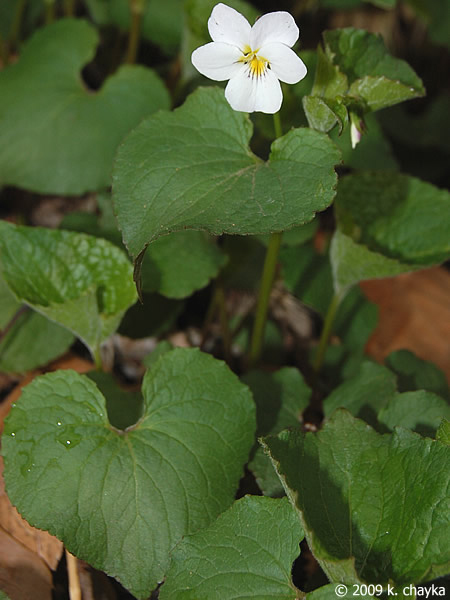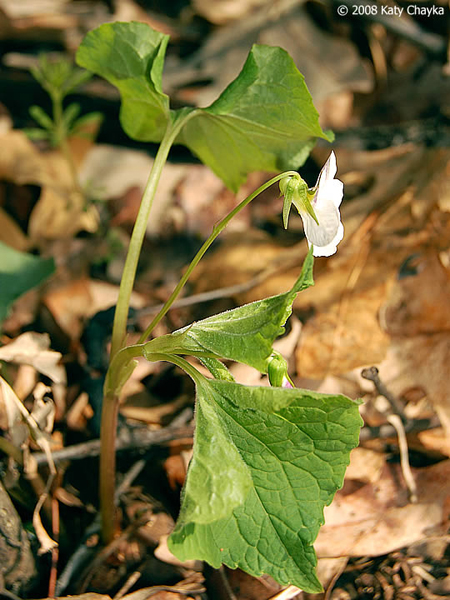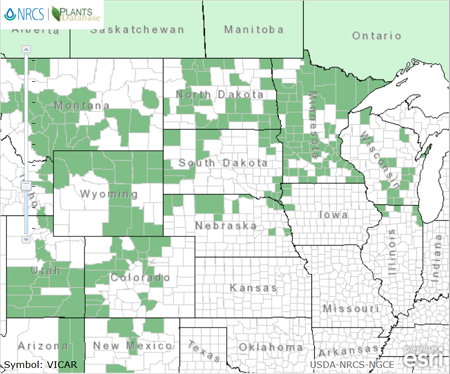Viola rugulosa Greene
Common names:
Great Plains White Violet, Rydberg's Violet
Synonyms:
Viola rugulosa Greene, Pittonia 5: 26. 1902; Viola canadensis L. var. rugulosa (Greene) C.L.Hitchc., Vasc. Pl. Pacific NorthW. 3: 442. 1961; Lophion rugulosum (Greene) Lunell, Amer. Midl. Naturalist 5: 238. 1918. TYPE: Minnesota, Hennepin Co., Rich woods, Jun 1891, J. H. Sandberg s.n. (HOLOTYPE: NDG32494!, internet image!).
Description:
Caulescent perennials, commonly densely colonial from thick stoloniform elongate rhizome often terminating in a plant, stems erect, solitary or multiple, ≤ 40 cm tall; stems, foliage and peduncle gray-green, densely hirtellous or hirsute; leaves cauline and basal, cauline distributed along stem; stipules membranous and commonly deciduous in fruit, free, lanceolate, entire; leaves ascending or spreading, leaf blades undivided, largest ≤ 90 × 101 mm, upper ovate with acute or subacuminate apex, middle and lower broadly ovate to reniform with acute or obtuse apex, base cordate, margins crenate-serrate, ciliate; chasmogamous flower ≤ 16 mm; calyx glabrous or hirtellous, ciliate; lowest sepals lanceolate to commonly linear-lanceolate, acute; auricles short and entire, not elongating in fruit; corolla white gradually fading to pink or pale purple on dorsal surface of petals, ventral surface of petals pink- or violet-tinged, throat yellow; spur short-globose; lateral petals densely bearded with slightly clavate hairs, spurred petal glabrous; cleistogamous flowers produced after chasmogamous; capsule 7.5–12 mm long, green drying tan, unspotted, papillate-puberulent or hirtellous to sparsely hirsute (infrequently glabrous); seeds 2.0–2.2 × 1.2–1.3 mm, light brown, unspotted, caruncle obsolete; 2n=24.
Similar species:
This species and V. canadensis share a white corolla with yellow throat, and an obsolete seed caruncle. This predominately Great Plains violet will most often be confused with V. canadensis, which appears not to grow at the same sites where their ranges slightly overlap in the western Midwest, and with V. eriocarpa (which does overlap in range and often grows with this) and V. striata (which ranges to the east and south). It differs from V. canadensis in its colonial or mat-forming habit due to long-creeping stoloniform rhizomes, densely hirtellous or hirsute foliage and peduncle, acute to subacuminate upper leaf blades with margins more remotely and less prominently crenate-serrate, deeply cordate basal leaf blades, and commonly linear-lanceolate usually glabrous or hirtellous ciliate sepals. It can be distinguished in chasmogamous flower from V. eriocarpa and V. striata by its membranous lanceolate entire stipules that are commonly deciduous in summer, and white corolla with yellow throat. In cleistogamous fruit, besides the stipule features and obsolete seed caruncle, it can be separated from V. eriocarpa by sharply acute apex and more numerous marginal teeth on the leaf blades; and from V. striata by the low crenate-serrate leaf blade margins, very short rounded auricles, and often papillate-puerulent to hirtellous capsule.
Viola canadensis, Viola eriocarpa, Viola striataEcology:
Moist loamy or sandy soils in mesic and dry-mesic forests along rivers and streams, sometimes in grasslands near forests.
Distribution:
W. Great Lakes region and n. Great Plains, WI to AB, south to n. IL, NE, CO and ID.
Rarity:
None.
Phenology:
Chasmogamous flower April–June, chasmogamous fruit May–July, cleistogamous fruit July–August.
Affinities:
This species belongs to the Yellow Violet lineage, sect. Chamaemelanium Ging., in the Canadenses species group.
Hybrids:
Although Russell (1965) and others have reported "intergradation" with V. canadensis, no compelling evidence to support hybridization has yet been presented.
Comments:
Greene stated in his protologue that this species was "...known to me only in specimens distributed by Mr. Sandberg, from 'rich woods in Hennepin Co., Minnesota, June, 1891." Greene cited only one collection in the protologue, but he gave no indication that this was represented by only one specimen, and he mentioned no herbarium. However, only one specimen was found in a search at NDG (NDG32494) and other herbaria known to harbor Greene's specimens. Greene identified that sheet as "Viola rugulosa, Greene, type!" in his own hand. There is sufficient evidence to justify accepting the NDG specimen as the holotype.
Brainerd (1921b), Brainerd Baird (1942), and Alexander (1963) recognize the present taxon as a species distinct from V. canadensis. Russell (1965), Scoggan (1978), Gleason and Cronquist (1991), Weakley et al. (2012), and Little and McKinney (2015) treated it as V. canadensis var. rugulosa (Greene) C.L.Hitchc. Some populations of otherwise typical V. canadensis in the southern Appalachian Mountains produce stoloniform rhizomes. Alexander and Gleason and Cronquist mistakenly included these in their circumscription of the present taxon. Russell's statement that this and V. canadensis "intergrade" in the zone of overlap has not been supported by examinations of many herbarium collections and limited field observations; the two taxa maintain their morphological distinctions in Illinois and Wisconsin, where their ranges overlap. I have seen no collections of the two from the same sites, indicating that there may be some degree of ecological isolation as well. While V. canadensis is confined to rich mesic woodlands, the present species often occurs in drier woodlands and extends beyond woodland borders into adjacent grassland areas. No instances of hybridization have been reported. Viola rugulosa is widespread and relatively common in the northern Great Plains, but the western limits of the taxon are still unclear. This taxon is still relatively poorly known and deserves further study.
Literature Cited:
Alexander, E. J. 1963. Violaceae. In Gleason, H. A., The new Britton and Brown illustrated flora of the northeastern United States and adjacent Canada. Hafner Publishing Co., Inc., New York, NY. 552-567.
Brainerd, E. 1921b. Violets of North America. Vermont Agricultural Experiment Station Bulletin 224: 1-172.
Brainerd Baird, V. 1942. Wild violets of North America. University of California Press, Berkeley, CA.
Fernald, M. L. 1950. Violaceae. In Gray’s Manual of Botany, 8th ed. American Book Company, New York, NY. 1022-1042.
Gleason, H. A., and A. Cronquist. 1991. Violaceae. In Manual of vascular plants of northeastern United States and adjacent Canada, 2nd ed. New York Botanical Garden, Bronx, NY. 157-163.
Little, R. J., and L. E. McKinney. 2015. Violaceae. In Flora of North America: Cucurbitaceae to Droseraceae, 106. Oxford University Press, New York, NY.
Russell, N. H. 1965. Violets (Viola) of the central and eastern United States: An introductory survey. Sida 2: 1-113.
Scoggan, H. J. 1978. Violaceae. In Flora of Canada, Part 3–Dicotyledoneae (Saururaceae to Violaceae). National Museums of Canada. Ottawa, Canada. 1103-1115.
Weakley, A. S., J. C. Ludwig, and J. F. Townsend. 2012. Violaceae. In Flora of Virginia. BRIT Press, Fort Worth, TX. 963-975.

Chasmogamous flowering habit by Peter M. Dziuk, "Minnesota Wildflowers" website

Chasmogamous flowering habit by Bruce Sorrie

Leaves and chasmogamous flower by Katy Chayka, "Minnesota Wildflowers" website

Chasmogamous flower front view by Peter M. Dziuk, "Minnesota Wildflowers" website

Chasmogamous flower profile view by Katy Chayka, "Minnesota Wildflowers" website

Map by USDA Plants Database (Rocky Mountain distribution is not confirmed)